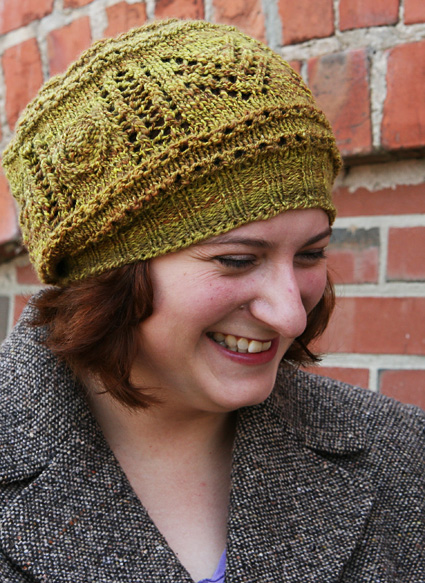

|
|
|

The whorl joined the stick to form the spindle as we know it in the Neolithic period. Whorls have been found in archaeological sites across the world, but sometimes are misidentified as beads or even, strangely, buttons because the wooden spindle shaft has long since rotted away. Ancient whorls were crafted from stone, pottery, bone, wood, and in later periods, glass. Inspired by the beautiful patterns scratched or painted onto these ancient spindle whorls, Whorled is knit from crown to brim. The slightly slouchy shape flatters many shapes of face, and the ribbed brim can easily be adjusted to fit a larger or smaller circumference head without impacting the rest of the hat design. Note the gauge: the sport-to-DK weight yarn is knit at a loose gauge for a drapey shape. Substituting a thicker yarn would create a denser, warmer hat. The handspun hat is knit using Bugga! fiber from Cephalopod Yarns. I saw the little bump of mottled greens and maroon at an impromptu trunk show at a friend's house and knew instantly that it wanted to be something earthy and ancient: the spindle whorl pulled straight from the ground at a dig site. I'd never spun a cashmere blend before, but Cephalopod Yarns made it surprisingly simple. The fiber was incredibly well blended, and the strength of the nylon helped to make up for any problems my cashmere-inexperience offered. Spinning from the fold with a short forward draw helped to keep the even blend of short and long stapled fibers and created a lofty yarn with a slight halo. Many thanks to Naomi Parkhurst for her support and help with this pattern, as well as for inspiring the take on a spindle whorl in the first place! |
||
|
|
 |
Tweet

|
|
SIZE |
|
|
FINISHED MEASUREMENTS |
|
MATERIALS
Tools |
|||||
|
GAUGE |
| 18 sts/24 rounds = 4 inches in stockinette stitch 20 sts/24 rounds = 4 inches in pattern stitch |
|
PATTERN NOTES |
|
This pattern starts at the top. You can use any cast on you like. The Disappearing Loop cast on creates a nice top. 1-to-3 inc: K1 tbl, leave stitch on needle. K1 through front loop. Remove stitch from left needle. Pick up the vertical bar under the second stitch, twist, and knit. 3 sts made from 1. 3-to-1 dec: Slip 1, slip the next, pass first slipped stitch over the second. Slip remaining stitch back to left needle. Pass second stitch over it. Knit remaining stitch. 3 sts decreased to 1. 1-to-5 inc: (K1, yo, k1, yo, k1) into the same sts. 5 sts made from 1.
Body Pattern |
|
DIRECTIONS Crown Rounds 18-21: Knit. Body of Hat Work as set until 18 rounds of Body Pattern are complete. BrimRounds 1-3: Knit. Round 4: Purl. Round 5: [Yo, k2tog] around. Round 6: Purl. Rounds 7-10: Knit. Round 11: Purl. Round 12: [Yo, k2tog] around. Round 13: Purl. Rounds 14-15: Knit Size M only, Round 16: [K3, k2tog] 20 times, k8. 88 sts. Size L only, Round 16: [K4, k2tog] 18 times, k6. 96 sts. Ribbing |
|
FINISHING |
| ABOUT THE DESIGNER |
|
Sarah Sipe fled a government job in Washington, DC, for a not-so-quiet job as a stay at home mom to two boys, two border collies, and three grey cats in Durham, NC. During the blessed hours of naptime, she knits, crochets, spins, and is learning to weave. She doesn't admit it to her husband, but yes, the baby's closet IS full of yarn. You can find her on Ravelry, blogging here or in her Ravelry group (with Naomi Parkhurst). |
|
Pattern & images © 2013 Sarah Sipe. Contact Sarah |